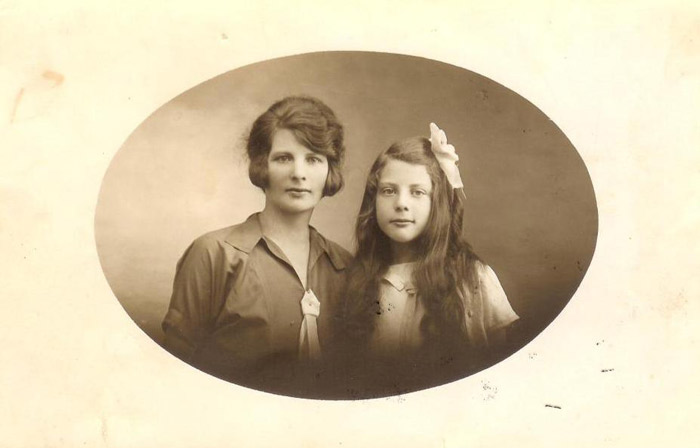Hole in the Clouds
Mar 27, 2012
 The woman in this picture, Emilienne, shown here in 1922 with her daughter, also named Emilienne, was a French war widow; her husband left for the army in 1914, when little Emilienne was an infant, and was killed in action in 1918, mort au champ d'honneur.
The woman in this picture, Emilienne, shown here in 1922 with her daughter, also named Emilienne, was a French war widow; her husband left for the army in 1914, when little Emilienne was an infant, and was killed in action in 1918, mort au champ d'honneur.
Little Emilienne remained small all her life, less than five feet tall, but lived to be ninety-seven in Dieppe, France, where she ran a waterfront cafe for sailors. "She ignored the meaning of a word like wickedness," recalls her grandson. "When I was five years old at her cafe, that's where I first tasted Calvados. I miss her deeply."
France
World War I
1922
Dieppe
(h/t: sebfrench76 via Shorpy)
Nov 11, 2013
 Veterans' Day is Armistice Day, except that it's not. Calendar-wise, they're the same, but pausing or parading to show gratitude for our veterans is not really the same as pausing to commemorate the moment 95 years ago when soldiers lay down their weapons and those among them who still had the vitality and the nerve climbed out of their trenches and tried to put World War I behind them.
Veterans' Day is Armistice Day, except that it's not. Calendar-wise, they're the same, but pausing or parading to show gratitude for our veterans is not really the same as pausing to commemorate the moment 95 years ago when soldiers lay down their weapons and those among them who still had the vitality and the nerve climbed out of their trenches and tried to put World War I behind them.
We know more than a few military men and women who squirm at hearing "Thank you for your service," which servicepeople hear all the time these days. All too often, what the people who say it really mean by it is: "Hey, I'm not one of those dirty hippies who burned their draft cards and stuff during Vietnam–I'm a real American, and here's my business card." Or something like that.
Still. We are grateful for our veterans and for all the people through the years who put their lives on the line for us. People sacrificed so much in so many wars, and way too many of those who benefited from their sacrifice are obnoxious Americans like me.
Anyways, VJ Day, much like Armistice Day, was a very good day for hundreds of millions of people around the world. We young folk know it mostly from Eistanstadt's iconic photo of a kiss in Times Square, recreated here in Lego by photographer Mike Stimpson.
New York
World War II
World War I
Vietnam
Alfred Eisenstadt
military
Lego
Times Square
Veterans Day
(Image credit: Mike Stimpson via mikestimpson.com)
Mar 18, 2016
 Sunday marks the 101st anniversary of the Gallipoli Campaign of World War I, when Allied forces tried and failed to gain control of the Dardanelles Straits connecting the Aegean and Mediterranean with the Sea of Marmara and the gateway to Asia, in what was then the Ottoman Empire. But honestly, we're not sure why Sunday is the official anniversary, since the nightmarish campaign actually began in January 1915 and dragged on for eight horrific months.
Sunday marks the 101st anniversary of the Gallipoli Campaign of World War I, when Allied forces tried and failed to gain control of the Dardanelles Straits connecting the Aegean and Mediterranean with the Sea of Marmara and the gateway to Asia, in what was then the Ottoman Empire. But honestly, we're not sure why Sunday is the official anniversary, since the nightmarish campaign actually began in January 1915 and dragged on for eight horrific months.
These bullets and many other similar specimens are on display in Turkey's Gallipoli historic museum. Pictures like this one show up on the internet from time to time as the spectacular consequence of "a mid-air collision." Although the two bullets did, of course, collide, the collision was apparently not in mid-air; no rifling marks are visible on the lighter-colored bullet, which we are told indicates that it was never fired. Perhaps it was in an ammunition clip or even a storage crate when it was struck by the darker-colored bullet.
More than 100,000 combatants died in the campaign, which involved Allied soldiers and sailors from England and France and many French and English colonies, including Newfoundland, New Zealand, India, and Senegal. The Ottoman forces that beat them back were led by Mustafa Ataturk, who went on to found the Republic of Turkey.
Ottoman Empire
World War I
Ataturk
Gallipoli
Dardanelles
mythbuster
bullets
(Image credit: Turkish Gallipoli historical museum)
 The woman in this picture, Emilienne, shown here in 1922 with her daughter, also named Emilienne, was a French war widow; her husband left for the army in 1914, when little Emilienne was an infant, and was killed in action in 1918, mort au champ d'honneur.
The woman in this picture, Emilienne, shown here in 1922 with her daughter, also named Emilienne, was a French war widow; her husband left for the army in 1914, when little Emilienne was an infant, and was killed in action in 1918, mort au champ d'honneur.  Veterans' Day is Armistice Day, except that it's not. Calendar-wise, they're the same, but pausing or parading to show gratitude for our veterans is not really the same as pausing to commemorate the moment 95 years ago when soldiers lay down their weapons and those among them who still had the vitality and the nerve climbed out of their trenches and tried to put World War I behind them.
Veterans' Day is Armistice Day, except that it's not. Calendar-wise, they're the same, but pausing or parading to show gratitude for our veterans is not really the same as pausing to commemorate the moment 95 years ago when soldiers lay down their weapons and those among them who still had the vitality and the nerve climbed out of their trenches and tried to put World War I behind them.